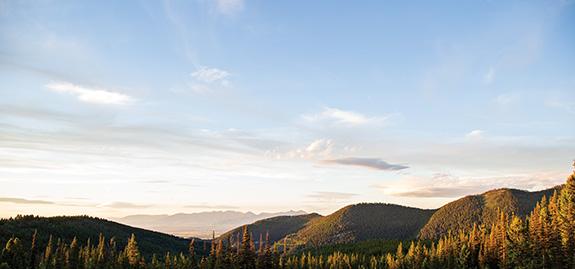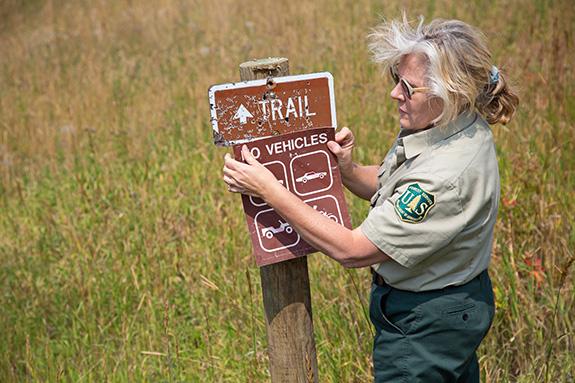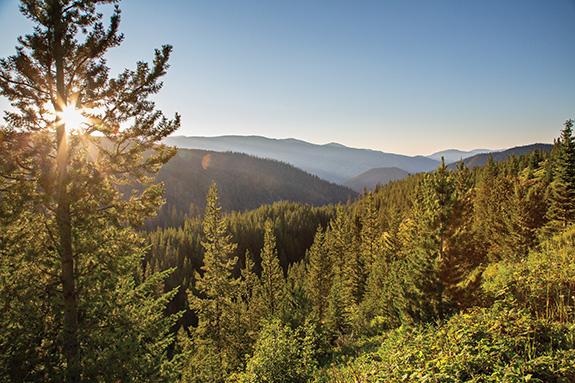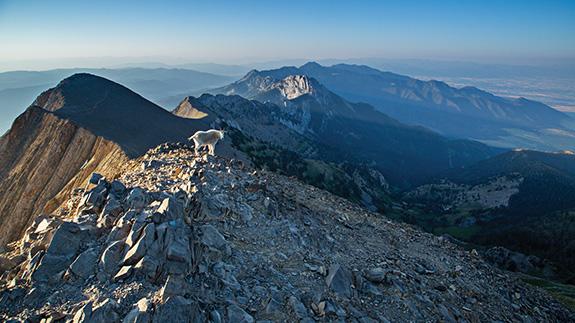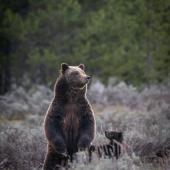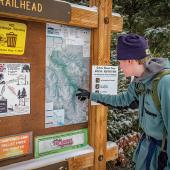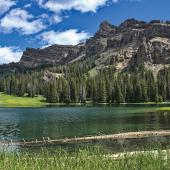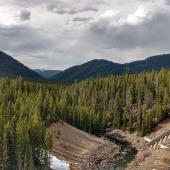We Before Me
Behind the scenes at the Custer-Gallatin National Forest.
For the better part of a decade, I drifted from one seasonal job to another. A worn atlas of North America served as my guide. I loved that atlas until Georgia tore away from the spiral spine and Montana lay crumpled on the passenger seat, the folds a miniature replica of the state’s topography. On these trips, national forests were my refuge. They provided me with a safe place to camp, often for free, and an escape from busy highways and crowded cities. These days, the 3.1 million-acre Custer-Gallatin National Forest is my refuge. But the Custer-Gallatin, like all national forests, is managed for multiple uses, which includes not only recreation but also grazing, timber harvest, and mining. Whether you agree with these uses or not, national forests are arguably the most egalitarian public lands in the U.S.
“The Forest Service operates under a big umbrella,” says Mary Erickson, the forest supervisor for the Custer-Gallatin. I meet Mary at her office in downtown Bozeman on a Friday afternoon. She greets me warmly and introduces me to a few members of her staff. Her bright-blue eyes are highlighted by shoulder-length ash-blond hair and a silk scarf tied casually around her neck. She looks downright joyful. And it’s no wonder. Mary has spent the last 35 years living and working on national forests.
“I don’t know if I can put my finger on it,” says Mary when I ask what inspired her career. “I just fell in love with western public lands.”
Mary was born is Boise, Idaho but spent her childhood moving around the country. She always loved being outdoors, but her family didn’t spend a lot of time hiking and camping. Perhaps her passion for the outdoors grew from living in Alaska and Utah, where there is more wilderness than one could explore in several lifetimes. Or maybe it was growing up at a time when landmark environmental policies like the Clean Air Act, Clean Water Act, and Endangered Species Act were passed. Whatever it was that inspired Mary, she has dedicated her career to ensuring the long-term sustainability of public lands. “I have no regrets,” she says.
In 1978 Mary moved to Oregon, where she attended Oregon State University, earning a bachelor’s degree in forest management and a master’s degree in forest economics. Before finishing her graduate degree in 1986, the Oregon State Department of Forestry hired her as a forester trainee.
While working for the state, Mary served as a dispatcher, an engine crew member, and a fire lookout. It wasn’t long, though, before Mary transitioned to the Forest Service. She swiftly rose through the ranks, serving as a district ranger and then as the deputy forest supervisor on Oregon’s Winema National Forest (now the combined Fremont-Winema National Forest).
Mary’s high aspirations continued to drive her career. Soon she earned a promotion to Forest Supervisor of the Fishlake National Forest in central Utah, where she oversaw and directed the work of four district rangers. Although Mary loved Utah, Montana has always captured her imagination. To her, the Big Sky state symbolizes freedom and epitomizes the romance of the west. So, when the Gallatin National Forest was looking for a forest supervisor, she didn’t hesitate.
In December 2007, Mary moved to Bozeman with her husband and two daughters. “This is my pinnacle,” she says.
But in 2014, the long-independent Custer and Gallatin national forests were combined, and Mary’s purview grew by 1.2 million acres. “It can be a bit unwieldy as a landscape,” she explains, “but people work well across boundaries, which ultimately makes it work.”
Those boundaries don’t just include the seven ranger districts she now oversees. The Custer-Gallatin borders private and state lands, Yellowstone National Park, tribal lands, the BLM, and four other national forests. The Forest’s seven ranger districts span the entire width of southern Montana and include a sliver of northwestern South Dakota. Within its boundaries, the Custer-Gallatin supports pine savannas and green ash woodlands, alpine ecosystems of whitebark and limber pine, sagebrush shrublands, and some of the most iconic rivers in the U.S.
I ask Mary if combining the two forests was a good example of efficiency. Mary doesn’t necessarily see it that way; the merger was motivated more by dwindling budgets, she says, than as a way to streamline. But, she explains, it was the best way to move forward and maintain district-level rangers. “They are the face of the Forest and really important for interacting with the public.”
The Custer-Gallatin is midway through drafting its first unified forest-management plan, which will provide guidance for the next 20 years or more. Early in her career, Mary says, while working in Oregon, forest management was mostly about what the Forest Service could provide, and what people wanted was timber. Today, the conversation on the Custer-Gallatin is more diverse.
When the two forests were merged, not only did ecological diversity increase, but so did social, economic, and cultural diversity. The Forest received more than 2,600 comments on the proposed management plan last spring. Comments ranged from expanding wilderness areas to opening some areas to mineral resource extraction.
As the forest supervisor, it’s Mary’s job to consider all viewpoints. Even though Mary is a low-impact user of public lands herself, she says that her professional position has made her more open-minded and appreciative of differing perspectives. But she also wants communities to have these conversations with each other as well with the Forest. Dialogue among Forest users can help promote consensus, at least on certain topics.
A good example of building consensus among community members is the Gallatin Forest Partnership, which is comprised of diverse stakeholders that came together specifically to iron out their differences regarding recreation and land use on the Custer-Gallatin. Through thoughtful discussion over the last few years, the Partnership drafted a unified set of recommendations that they then submitted to the Forest.
“When people talk about forest management, what they are mostly talking about are values,” says Mary. The purpose of the Forest Plan is to link those competing values to actions. “All actions will have an effect, but our ultimate goal is to sustain natural resources for the long-term,” she explains. But Mary emphasizes that to sustain resources for the long-term, management actions must be rooted in science.
Mary isn’t interested in managing the Custer-Gallatin to look just like it did 100 years ago. Instead, she aspires to maintain natural processes, promote ecosystem resilience, conserve watersheds, and grow and sustain healthy wildlife populations.
“People don’t always understand the investment and what it takes to manage a forest sustainably,” says Mary. She wonders how she and her staff can raise awareness of that challenge. One strategy is to expand partnerships. With a budget that has not kept pace with management needs, Mary says that partnerships are critical to helping the Custer-Gallatin achieve its goals, especially as they implement the new management plan in 2020.
Partnerships with the Forest go beyond commenting on what the Custer-Gallatin should do to manage our shared resources. Investment in terms of money, volunteerism, and even personal stewardship, like picking up trash and practicing Leave No Trace ethics, are all important contributions. After all, recreating in the Forest is the best deal around. It’s cheap or even free. But effective stewardship also entails understanding and appreciating how the Forest functions.
Fire is perhaps the most influential natural process and one of the biggest social and economic challenges that the Custer-Gallatin faces. In 2017, more than 1.3 million acres burned in Montana, costing more than $74 million, according to the Northern Rockies Coordination Center and the Montana Department of Natural Resources and Conservation (only 16 of those acres burned in the Custer-Gallatin). After Montana’s 2017 fire season, there was a lot of rhetoric that land managers can and should be preventing fires. “That’s just not going to happen,” says Mary. “We live in a fire-adapted system.”
Besides, land managers tried controlling and suppressing fires for more than 100 years. The era of fire suppression led to more fuels, which has contributed to the larger and longer-running fires we see today. And, there are many areas in the Custer-Gallatin where controlling fire would be impossible and even life-threatening (two firefighters died battling Montana’s fires in 2017). With longer fire seasons as the climate changes, we can expect more areas of the Custer-Gallatin to burn for even longer.
I ask Mary if she’s concerned about climate change in the Forest and, if so, how she plans to adapt to it. But, says Mary, she and her staff don’t necessarily use the words “climate change” in their management actions. Current administration aside, climate change is such a big and overwhelming topic. The phrase can divide people immediately and forever. Dealing with climate change feels overwhelming and even hopeless at times. By leaving that language aside, forest managers can focus on the details of a restoration project that is, in essence, climate adaptive.
Some of these projects include cutthroat-trout restoration in high-elevation headwater streams that are likely to remain temperature-stable even as the regional climate warms. Or partnering with the National Park Service to produce blister-rust-resistant whitebark pine known as “plus” trees. Another project includes restoring aspen across the Forest.
Individual projects like these put climate-change adaptation into realistic and tangible terms that the public can relate to without the weight of the words “climate change.” But the Forest isn’t shying away from the topic, either. In its 2017 report entitled Final Assessment Report of Ecological, Social and Economic Conditions on the Custer Gallatin National Forest, climate change is addressed in the very first section, right after the introduction and a quote from Al Gore.
There are also more local threats. One of the Custer-Gallatin’s biggest challenges, explains Mary, is determining what the agency’s role is in managing increased visitor use. “The Forest Service looks to provide access and allow for a variety of uses with the least amount of control or regulation,” she says. Regulations are in place to protect resources and public safety, but they can be difficult to enforce given that current funding has not kept pace with visitation.
Mary cites Hyalite Canyon as a good example of a high-use area that presents a management challenge. According to the U.S. Census Bureau, about 46,500 people live in Bozeman, with a growth rate of about 25% since 2010. Hyalite is Bozeman’s playground with more and more people recreating in the area each year. Try getting a campsite on a Tuesday evening during the height of summer and you may have trouble. The trails are busy and full of hikers, mountain bikers, and equestrians. To alleviate some of the pressure, the Forest has implemented a shared-use strategy that reduces conflict between users and increases visitor enjoyment.
“In these high-use areas, maybe we need more infrastructure as well,” says Mary. Infrastructure like pit toilets, picnic tables, large parking areas, and more signage so that the impact on the landscape is regulated. While in more lightly visited areas, Mary would rather limit the human footprint to maintain the existing untrammeled character of the landscape. “There is no magic solution that will work across the entire Forest,” says Mary.
When I first contacted Mary for an interview she agreed (almost) right away, but she wanted to ensure that we would also discuss the value of public lands and the challenges that the Custer-Gallatin faces. Mary wasn’t interested in talking much about herself. But at the risk of sounding hokey, perhaps by talking about public lands, Mary was giving some insight into who she is as a person.
Mary’s entire career has been immersed in public-lands management, mostly federal lands. She spends much of her free time recreating in the Custer-Gallatin. “I never take public lands for granted,” she says.
Landscape has shaped her both professionally and personally. And for those of us lucky enough to live in Montana, where there are more acres of public land than there are acres of development, landscape shapes all of us, too. The Custer-Gallatin surrounds us. We see it every time we peer out of office windows waiting for Friday to roll around. We post pictures of wildflowers and alpine lakes on social media just to make out-of-state friends and family jealous. We tell stories about our adventures on Monday morning, always wishing that the weekends were longer.
After I spoke with Mary, I headed to the Fairy Lake campground on the east side of the Bridgers. Over the next three days I meandered around Fairy Lake, climbed Sacajawea Peak, and crested the saddle above Frazier Lake. My dog, Meg, galloped along, thrilled to be off-leash. Tufts of white mountain-goat hair clung to shrubs and branches. A golden eagle soared overhead, sending the marmots into a frenzy of alarm. The last time I camped on the Bridgers’ east side was many years ago as a graduate student at MSU. It is still breathtaking. Still inspiring.
“There is so much appreciation for public lands in Montana,” says Mary. She may be the forest supervisor, but we are all stewards of the Custer-Gallatin, and it is ultimately up to us how we want the Forest managed into the future. We just need the wisdom to not only meet our own needs, but the needs of the Forest as well.


